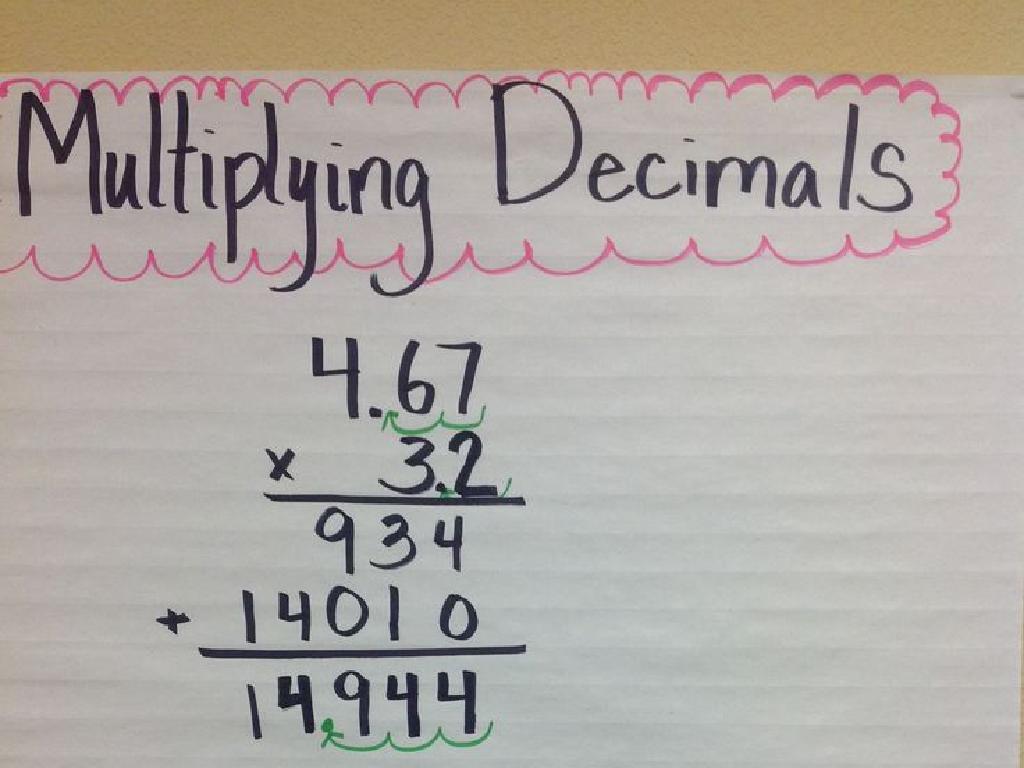Draw Angles With A Protractor
Subject: Math
Grade: Fourth grade
Topic: Angle Measurement
Please LOG IN to download the presentation. Access is available to registered users only.
View More Content
Mastering Angles with a Protractor
– Learn to draw angles using a protractor
– A protractor helps us draw precise angles
– Understanding the basics of angles
– Angles are a measure of turn between two lines
– Measuring angles accurately
– Place the protractor’s center on the angle’s vertex
– Drawing angles independently
– Practice by replicating given angle measurements
|
This slide introduces the concept of angle measurement to fourth-grade students, emphasizing the use of a protractor. Begin by explaining what angles are and their importance in geometry. Demonstrate how to position the protractor on the paper and align it with one line of the angle. Show how to read the measurements on the protractor to find the degree of the angle. Then, guide students through the process of using these measurements to draw an angle of their own. Encourage students to practice with different angle sizes and to check their work by measuring the drawn angles. Provide several examples and hands-on activities to ensure students feel comfortable with the process.
Understanding Angles
– Definition of an angle
– Two lines meet at a point to form an angle
– Angles are measured in degrees
– Degrees tell us the size of an angle
– The vertex: where lines meet
– The common point of the lines is the vertex
– Exploring examples of angles
– Look at right, acute, and obtuse angles
|
Begin the lesson by explaining what an angle is, emphasizing that it’s formed by two lines meeting at a point called the vertex. Clarify that the space between the lines is measured in degrees, which tells us the size of the angle. Show visual examples of different types of angles such as right angles (90 degrees), acute angles (less than 90 degrees), and obtuse angles (more than 90 degrees but less than 180 degrees). Use a protractor to demonstrate how angles are measured. Encourage students to think of real-life examples where angles are used, such as corners of a book or the hands of a clock.
Types of Angles
– Acute Angle: Less than 90°
– An angle smaller than a right angle, like a slice of pizza.
– Right Angle: Exactly 90°
– Like the corners of a square or the hands of a clock at 3 o’clock.
– Obtuse Angle: More than 90°
– Larger than a right angle but doesn’t go straight across, like a fan slightly open.
– Straight Angle: 180°
|
This slide introduces students to the basic types of angles they will encounter and use when measuring with a protractor. An acute angle is sharp and less than 90 degrees, often compared to a sharp object like a pizza slice. A right angle is the most standard angle type, representing the corner of a square or the letter ‘L’. An obtuse angle is wider, like an open book or a fan that’s not fully extended. A straight angle is a straight line, representing 180 degrees. Encourage students to find examples of these angles in the classroom and at home to help solidify their understanding. During the next class, practice drawing these angles with a protractor.
How to Use a Protractor
– A protractor measures angles
– It’s a half-circle tool for angle measurement
– Degrees marked from 0 to 180
– The curved edge has numbers showing degrees
– Place midpoint at angle vertex
– The vertex is where the two lines of an angle meet
– Line up one ray with zero degrees
– Ensures accurate measurement from the start point
|
This slide introduces students to the basics of using a protractor to measure angles. Emphasize that a protractor is a semi-circular tool with degree markings that help us find the size of an angle. Show them how to correctly place the protractor by aligning the midpoint with the angle’s vertex and one ray with the zero-degree line on the protractor. This ensures that the measurement starts correctly. Demonstrate this with a protractor in class and provide several examples for practice. Encourage students to handle the protractor carefully and align it precisely for accurate measurements.
Drawing Angles with a Protractor
– Position the protractor on paper
– Ensure the baseline of the protractor is aligned with one side of the angle.
– Find the degree mark for your angle
– The degree scale helps us measure the angle’s size.
– Mark the paper at the right degree
– A small pencil mark will guide where the angle will open to.
– Draw the second line to the mark
– Connect the vertex to the mark to complete the angle.
|
This slide guides students through the process of using a protractor to draw angles. Start by placing the protractor’s baseline along one side of the angle, ensuring it’s aligned with the zero mark. Show students how to locate the desired degree on the protractor’s scale for the angle they wish to draw. Emphasize the importance of making a precise mark on the paper at the correct degree point. Finally, instruct them to remove the protractor and draw a straight line from the angle’s vertex to the mark they’ve made. Encourage practice by having students draw angles of various sizes. Provide several examples and possibly a hands-on activity where students can draw angles on their own.
Practice Time: Drawing a 30-Degree Angle
– Let’s draw a 30-degree angle
– Follow the steps we learned
– Line up the protractor carefully
– Make sure the baseline of the angle matches the protractor’s zero line
– Check your angle with a partner
– Compare your angle with a classmate’s to see if they are the same
|
This slide is designed for a hands-on activity where students will apply their knowledge of using a protractor to draw a 30-degree angle. Remind them to follow the step-by-step process discussed in the lesson, such as placing the midpoint of the protractor on the vertex of the angle and aligning one ray with the zero line. Emphasize the importance of accuracy in lining up the protractor to ensure a precise measurement. After they have drawn the angle, encourage students to work with a partner to compare their angles, fostering peer learning and collaboration. As a teacher, circulate the room to provide guidance and support as needed. Possible activities include drawing angles of different measures, finding angles in their environment, or creating an angle-measuring scavenger hunt.
Class Activity: Angle Art Creation
– Create your own angle art
– Draw angles with a protractor
– Use the protractor to measure and draw angles of various sizes.
– Combine angles into a picture
– Get creative! Make a picture or pattern using the angles you’ve drawn.
– Present your art to the class
|
This activity is designed to give students hands-on experience with drawing and measuring angles using a protractor. Encourage creativity as they combine different angles to create unique art pieces. Provide a variety of protractors and colored pencils to aid their designs. As a teacher, circulate the room to assist with protractor use and to ensure students understand how to measure angles accurately. Possible variations of the activity could include: creating specific themed art (e.g., underwater scene, space), collaborative group art, or a challenge to use certain angles in their design. After completion, allow students to present their angle art to the class, explaining the angles they used and the creative process behind their artwork.
Review: Angles and Protractors
– Recap on using protractors
– Measuring a 90-degree angle
– Who can demonstrate measuring a right angle with a protractor?
– Open floor for questions
– Share your learnings
– Any interesting facts or tips you discovered?
|
This slide is meant to consolidate the day’s learning and encourage student participation. Start by asking the class to summarize the steps in using a protractor to draw and measure angles. Then, invite a volunteer to come up and measure a 90-degree angle on the board, providing guidance as needed. Open the floor to the class for any questions they may have or if they need clarification on any part of the lesson. Finally, encourage students to share something new they learned or a helpful strategy they used during the lesson. This interactive review helps reinforce their understanding and allows them to learn from each other.






